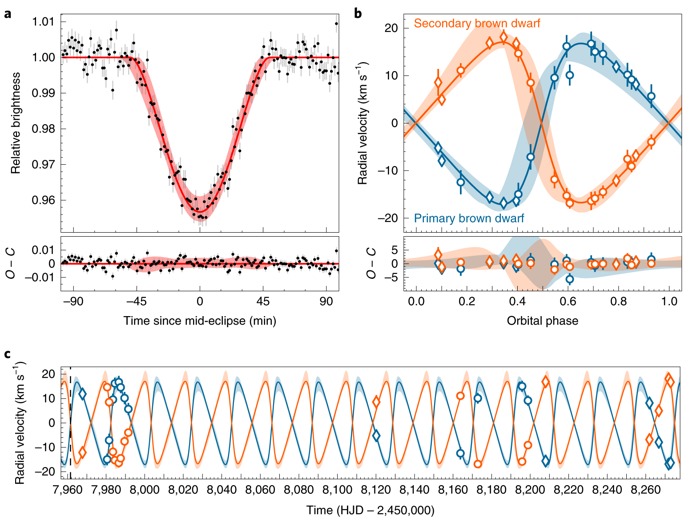Nature Astronomy ( IF 14.1 ) Pub Date : 2020-03-09 , DOI: 10.1038/s41550-020-1018-2 Amaury H. M. J. Triaud , Adam J. Burgasser , Artem Burdanov , Vedad Kunovac Hodžić , Roi Alonso , Daniella Bardalez Gagliuffi , Laetitia Delrez , Brice-Olivier Demory , Julien de Wit , Elsa Ducrot , Frederic V. Hessman , Tim-Oliver Husser , Emmanuël Jehin , Peter P. Pedersen , Didier Queloz , James McCormac , Catriona Murray , Daniel Sebastian , Samantha Thompson , Valérie Van Grootel , Michaël Gillon

|
Mass, radius and age are three of the most fundamental parameters for celestial objects, enabling insight into the evolution and internal physics of stars, brown dwarfs and planets. Brown dwarfs are hydrogen-rich objects that are unable to sustain core fusion reactions but are supported against collapse by electron degeneracy pressure1. As they age, brown dwarfs cool, reducing their radius and luminosity. Young exoplanets follow a similar behaviour. Brown dwarf evolutionary models are relied upon to infer the masses, radii and ages of young brown dwarfs2,3. Similar models are also used to infer the mass and radius of directly imaged exoplanets4. Unfortunately, only sparse empirical mass, radius and age measurements are currently available, and so the models remain mostly unvalidated. Double-line eclipsing binaries provide the most direct route towards the absolute determination of the masses and radii of stars5,6,7. Here we report the discovery by SPECULOOS (Search for habitable Planets EClipsing ULtra-cOOl Stars) of the 2M1510A triple system, consisting of a nearby, eclipsing, double-line brown dwarf binary and a widely separated tertiary brown dwarf companion. We find that the system is a member of Argus, a 45 ± 5 million-year-old moving group8,9. The system’s age matches those of currently known directly imaged exoplanets so 2M1510A provides an opportunity to benchmark evolutionary models of brown dwarfs and young planets. We find that widely used evolutionary models3 do reproduce the mass, radius and age of the binary components remarkably well, but overestimate their luminosity by up to 0.65 magnitudes, which could result in underestimations of 20% to 35% of photometric masses for directly imaged exoplanets and young-field brown dwarfs.
中文翻译:

SPECULOOS发现的年轻三重系统中的黯淡的星际双星
质量,半径和年龄是天体的三个最基本参数,可以洞察恒星,褐矮星和行星的演化和内部物理学。棕矮星是富含氢的物体,无法维持核聚变反应,但受到电子简并压力1的破坏而被支撑。随着年龄的增长,棕色小矮人会变凉,从而减小它们的半径和亮度。年轻的系外行星也遵循类似的行为。依靠褐矮星的演化模型来推断幼小的褐矮星2,3的质量,半径和年龄。类似的模型也用于推断直接成像的系外行星的质量和半径4。不幸的是,目前只有稀疏的经验质量,半径和年龄测量可用,因此模型大部分仍未得到验证。双线日蚀双星提供了最直接的途径,可以绝对地确定恒星5,6,7的质量和半径。在这里,我们报告了SPECULOOS(搜寻可食的行星使超冰星黯然失色)对2M1510A三重系统的发现,该系统由一个附近的,黯淡的双线褐矮星双星和一个广泛分离的三阶褐矮星同伴组成。我们发现系统是Argus的成员,Argus是一个有45±5百万年历史的移动小组8,9。该系统的年龄与目前已知的直接成像的系外行星的年龄相匹配,因此2M1510A提供了一个基准,可以对褐矮星和年轻行星的演化模型进行基准测试。我们发现,广泛使用的进化模型3确实能够很好地重现二进制组件的质量,半径和年龄,但是将其光度高估了0.65个数量级,这可能导致低估了直接成像的光度质量的20%到35%。系外行星和年轻野棕色矮星。



























 京公网安备 11010802027423号
京公网安备 11010802027423号